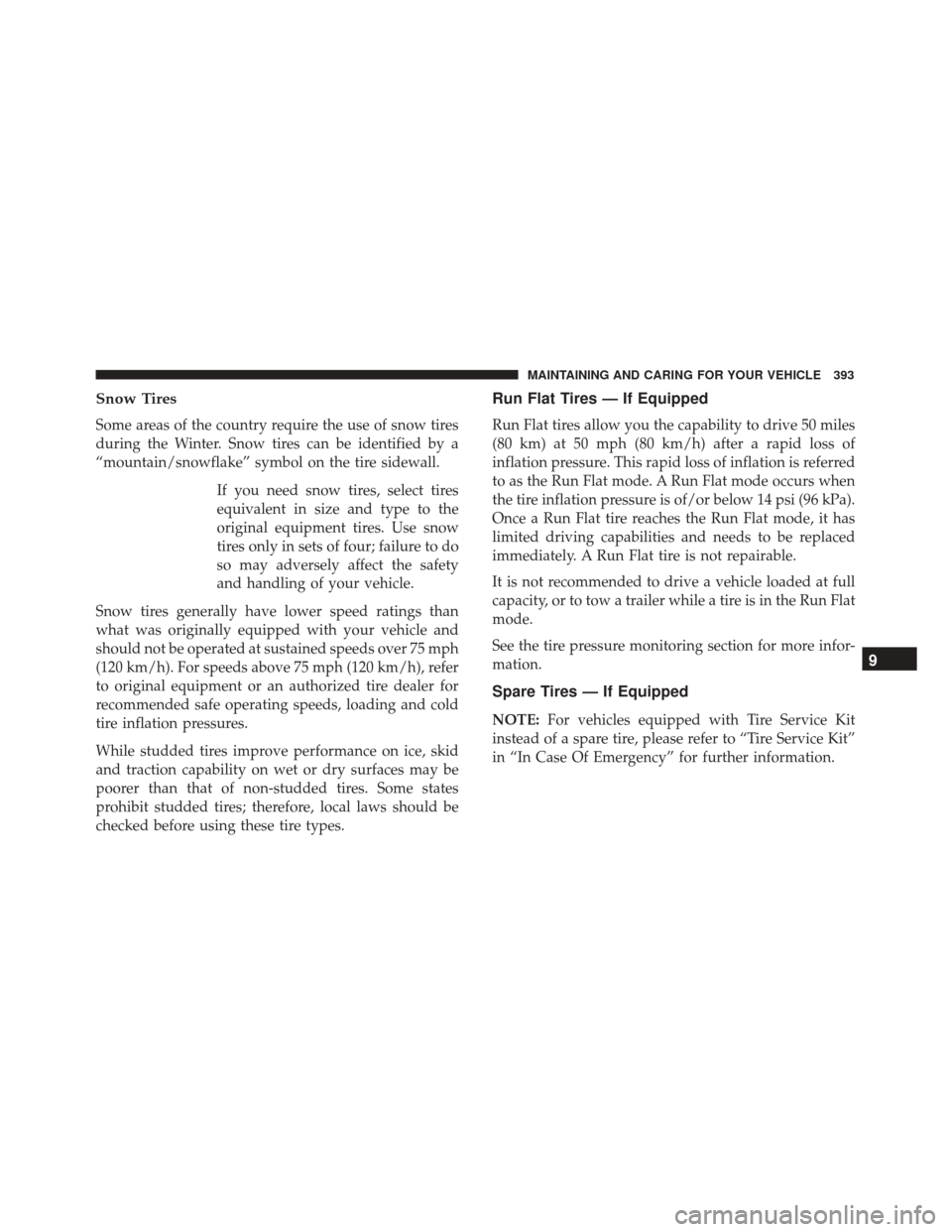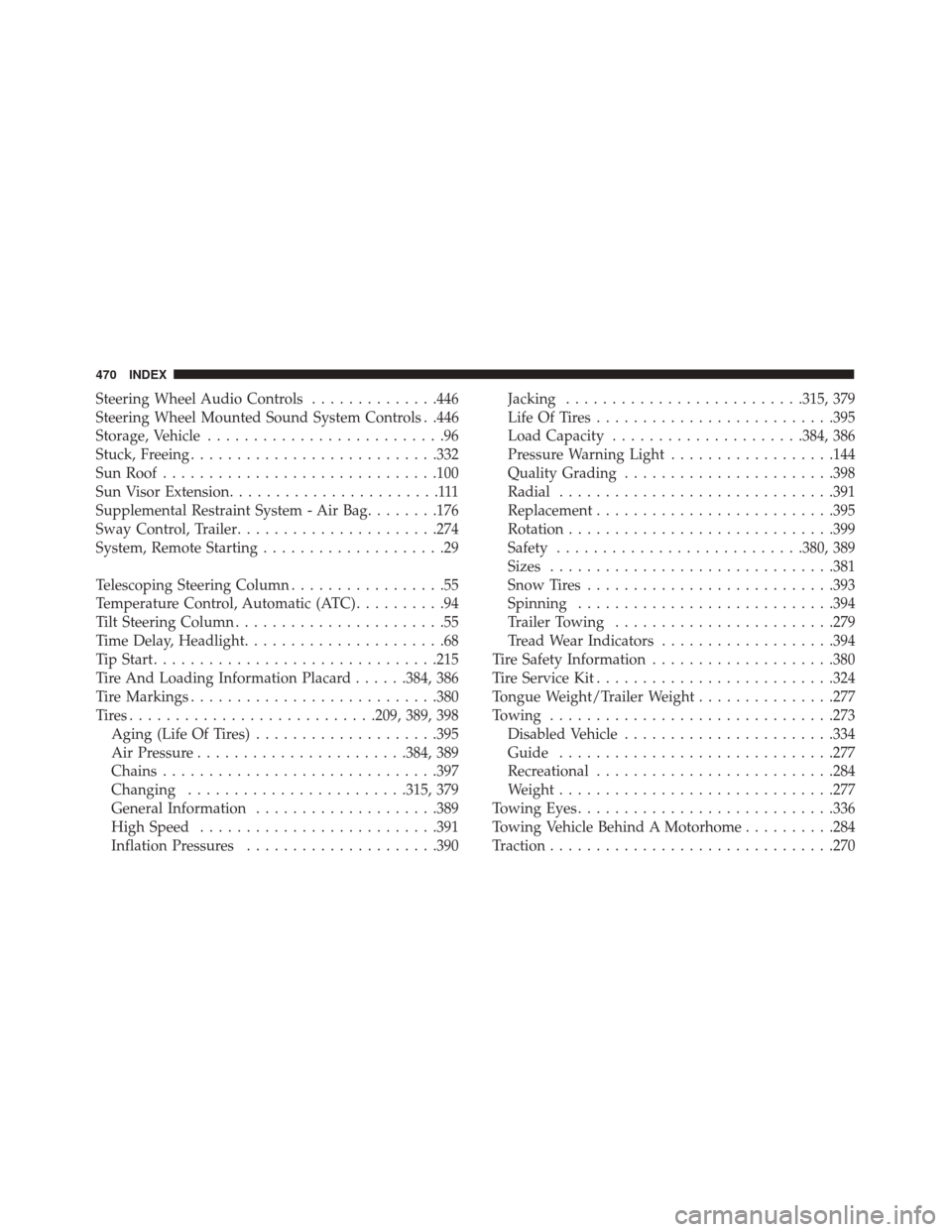Page 393 of 476

Example: If garage temperature = 68°F (20°C) and the
outside temperature = 32°F (0°C) then the cold tire
inflation pressure should be increased by 3 psi (21 kPa),
which equals 1 psi (7 kPa) for every 12°F (7°C) for this
outside temperature condition.
Tire pressure may increase from 2 to 6 psi (13 to 40 kPa)
during operation. DO NOT reduce this normal pressure
build up or your tire pressure will be too low.
Tire Pressures For High Speed Operation
The manufacturer advocates driving at safe speeds and
within posted speed limits. Where speed limits or
conditions are such that the vehicle can be driven at
high speeds, maintaining correct tire inflation pressure
is very important. Increased tire pressure and reduced
vehicle loading may be required for high-speed vehicle
operation. Refer to your authorized tire dealer or origi-
nal equipment vehicle dealer for recommended safe
operating speeds, loading and cold tire inflation pres-
sures.
WARNING!
High speed driving with your vehicle under maxi-
mum load is dangerous. The added strain on your
tires could cause them to fail. You could have a
serious collision. Do not drive a vehicle loaded to
the maximum capacity at continuous speeds above
75 mph (120 km/h).
Radial Ply Tires
WARNING!
Combining radial ply tires with other types of tires
on your vehicle will cause your vehicle to handle
poorly. The instability could cause a collision. Al-
ways use radial ply tires in sets of four. Never
combine them with other types of tires.
9
MAINTAINING AND CARING FOR YOUR VEHICLE 391
Page 395 of 476

Snow Tires
Some areas of the country require the use of snow tires
during the Winter. Snow tires can be identified by a
“mountain/snowflake” symbol on the tire sidewall.If you need snow tires, select tires
equivalent in size and type to the
original equipment tires. Use snow
tires only in sets of four; failure to do
so may adversely affect the safety
and handling of your vehicle.
Snow tires generally have lower speed ratings than
what was originally equipped with your vehicle and
should not be operated at sustained speeds over 75 mph
(120 km/h). For speeds above 75 mph (120 km/h), refer
to original equipment or an authorized tire dealer for
recommended safe operating speeds, loading and cold
tire inflation pressures.
While studded tires improve performance on ice, skid
and traction capability on wet or dry surfaces may be
poorer than that of non-studded tires. Some states
prohibit studded tires; therefore, local laws should be
checked before using these tire types.
Run Flat Tires — If Equipped
Run Flat tires allow you the capability to drive 50 miles
(80 km) at 50 mph (80 km/h) after a rapid loss of
inflation pressure. This rapid loss of inflation is referred
to as the Run Flat mode. A Run Flat mode occurs when
the tire inflation pressure is of/or below 14 psi (96 kPa).
Once a Run Flat tire reaches the Run Flat mode, it has
limited driving capabilities and needs to be replaced
immediately. A Run Flat tire is not repairable.
It is not recommended to drive a vehicle loaded at full
capacity, or to tow a trailer while a tire is in the Run Flat
mode.
See the tire pressure monitoring section for more infor-
mation.
Spare Tires — If Equipped
NOTE: For vehicles equipped with Tire Service Kit
instead of a spare tire, please refer to “Tire Service Kit”
in “In Case Of Emergency” for further information.
9
MAINTAINING AND CARING FOR YOUR VEHICLE 393
Page 397 of 476

tread is worn to the tread wear indicators, the tire
should be replaced. Refer to “Replacement Tires” in this
section for further information.
Life Of Tire
The service life of a tire is dependent upon varying
factors including, but not limited to:
•Driving style.
• Tire pressure – Improper cold tire inflation pressures
can cause uneven wear patterns to develop across the
tire tread. These abnormal wear patterns will reduce
tread life, resulting in the need for earlier tire replace-
ment.
• Distance driven.
• Performance tires, tires with a speed rating of V or
higher, and Summer tires typically have a reduced
tread life. Rotation of these tires per the vehicle
maintenance schedule is highly recommended.
WARNING!
Tires and the spare tire should be replaced after six
years, regardless of the remaining tread. Failure to
(Continued)
WARNING! (Continued)
follow this warning can result in sudden tire fail-
ure. You could lose control and have a collision
resulting in serious injury or death.
Keep dismounted tires in a cool, dry place with as little
exposure to light as possible. Protect tires from contact
with oil, grease, and gasoline.
Replacement Tires
The tires on your new vehicle provide a balance of
many characteristics. They should be inspected regu-
larly for wear and correct cold tire inflation pressures.
The manufacturer strongly recommends that you use
tires equivalent to the originals in size, quality and
performance when replacement is needed. Refer to the
paragraph on “Tread Wear Indicator” in this section.
Refer to the Tire and Loading Information placard or
the Vehicle Certification Label for the size designation
of your tire. The Load Index and Speed Symbol for your
tire will be found on the original equipment tire side-
wall.
9
MAINTAINING AND CARING FOR YOUR VEHICLE 395
Page 472 of 476

Steering Wheel Audio Controls..............446
Steering Wheel Mounted Sound System Controls . .446
Storage, Vehicle ..........................96
Stuck, Freeing .......................... .332
Sun Roof ............................. .100
Sun Visor Extension .......................111
Supplemental Restraint System - Air Bag ........176
Sway Control, Trailer ..................... .274
System, Remote Starting ....................29
Telescoping Steering Column .................55
Temperature Control, Automatic (ATC) ..........94
Tilt Steering Column .......................55
Time Delay, Headlight ......................68
Tip Start .............................. .215
Tire And Loading Information Placard ......384, 386
Tire Markings .......................... .380
Tires.......................... .209, 389, 398
Aging (Life Of Tires) ....................395
Air Pressure ...................... .384, 389
Chains ............................. .397
Changing ....................... .315, 379
General Information ....................389
High Speed ......................... .391
Inflation Pressures .....................390 Jacking
......................... .315, 379
Life Of Tires ......................... .395
Load Capacity .....................384, 386
Pressure Warning Light ..................144
Quality Grading ...................... .398
Radial ............................. .391
Replacement ......................... .395
Rotation ............................ .399
Safety .......................... .380, 389
Sizes .............................. .381
Snow Tires .......................... .393
Spinning ........................... .394
Trailer Towing ....................... .279
Tread Wear Indicators ...................394
T
ire Safety Information ....................380
Tire Service Kit ......................... .324
Tongue Weight/Trailer Weight ...............277
Towing .............................. .273
Disabled Vehicle ...................... .334
Guide ............................. .277
Recreational ......................... .284
Weight ............................. .277
Towing Eyes ........................... .336
Towing Vehicle Behind A Motorhome ..........284
Traction .............................. .270
470 INDEX
Page:
< prev 1-8 9-16 17-24